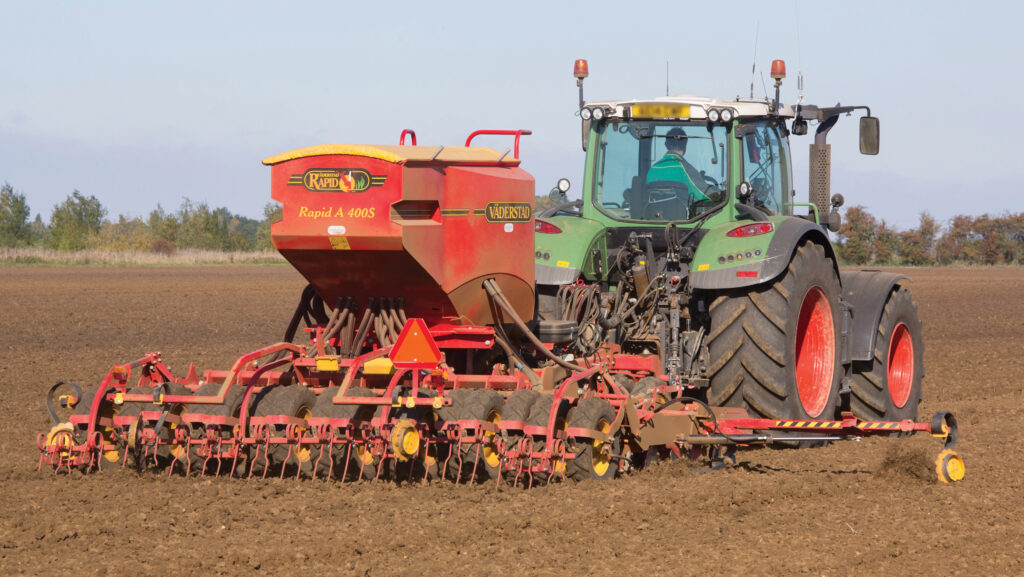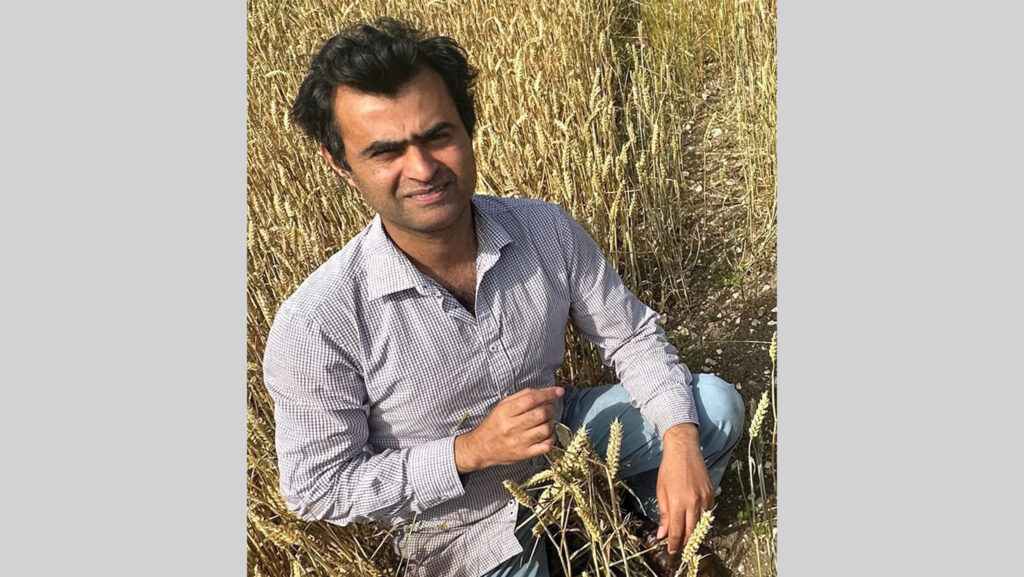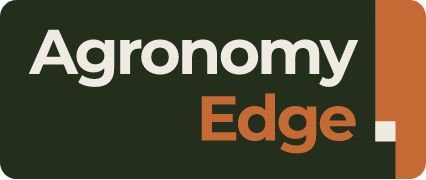Why variety and drill date are key to yield and disease
 © Tim Scrivener
© Tim Scrivener Growers looking to reduce fungicide use and reliance on synthetic chemistry are advised to start by focusing on two key decisions: variety choice and drilling date.
While there is growing interest in biologicals as tools to reduce fungicide use and support crop health, the largest and most consistent differences in yield and disease still come from choosing the right variety and the right drill date.
See also: How two farmers integrate strategic glyphosate in rotations
“When assessing how to sustainably manage disease and maintain yield, variety choice and drilling date have a far greater influence on both yield and disease pressure than any single biostimulant or product claim,” explains Dr Syed Shah, a Niab agronomist and crop researcher.
Long before any spray is applied, decisions on variety and drilling date fundamentally shape crop architecture, canopy development, and exposure to pest and disease risk.
Evidence from Niab trials
Trials carried out by Niab last season revealed up to a 5t/ha yield difference when exploring the interaction between drilling date, variety, and fungicide programmes.
The Group 2 winter wheat varieties Extase and Palladium were sown on two dates:
- 13 September (early drilling)
- 11 October (late drilling)
Across five fungicide programmes ranging from untreated to intensive five-spray strategies, the trial demonstrated the powerful effect of drilling date alone.
Drilling date had a significant effect on yield. Averaged across fungicide programmes, the October-drilled Extase yielded 5t/ha higher than the September drilling, with the later-sown crop maintaining cleaner leaves.
Later drilling also avoided early pest problems such as gout fly which affected the September-drilled plots.
October-drilled Palladium outperformed Extase by 1.6t/ha, while the September drilled Palladium outperformed Extase by 2.1t/ha.
Yield by drilling date (t/ha) |
||
|
Variety |
13 September |
11 October |
|
Extase |
4.7 |
9.8 |
|
Palladium |
6.8 |
8.4 |
Syed says managing disease pressure starts with the seed-bed.
“Early drilling may seem appealing for spreading workload and establishing crops ahead of winter, but it comes with trade-offs,” he says.
Earlier crops typically face:
- Barley yellow dwarf virus and gout fly
- Higher grassweed pressure such as blackgrass
- Reduced effectiveness of residual herbicides in dry conditions
- Higher disease risk – yellow rust, septoria, mildew
- Increased lodging potential
- Greater reliance on plant growth regulators.
“Early drilling increases the need for fungicides and other chemical inputs such as insecticides and herbicides. That’s exactly what many growers are aiming to reduce,” explains Syed.
Later drilling, by contrast, naturally lowers disease pressure, helping to reduce fungicide intensity and overall cost.
“In the September-drilled crop there was no slug or herbicide, but gout-fly damage was present, whereas in the 11 October crop there was no slug, herbicide or gout-fly damage,” he notes.

Dr Syed Shah © Niab
Fungicide cost comparison
Five fungicide programmes were demonstrated, ranging from untreated to intensive five-spray strategies, with costs ranging from £90/ha for a two-spray programme to £200/ha for a five-spray programme.
However, no significant differences were seen among the fungicide treatments in terms of their effect on grain yield.
Even with the highest level of protection, early-drilled crops struggled to match the yields of later-drilled plots due to pest and disease pressure.
This underlined that the timing of drilling and the variety’s genetic resistance traits are more decisive than chemical spend alone.
Fungicide programmes including application timings and targeted leaf layers |
|||||
|
Treatment |
Leaf 4 |
Leaf 3 |
Leaf 2 |
Leaf 1 |
Leaf 1 + 15 days later |
|
1 |
Untreated |
Untreated |
Untreated |
Untreated |
Untreated |
|
2 |
Tebuconazole 125g/ha |
Tebuconazole 125g/ha + Revystar 1 litre/ha |
Untreated |
Tebuconazole 125g/ha + Univoq 1.25 litres/ha |
Untreated |
|
3 |
Tebuconazole 125g/ha + Arizona 1 litre/ha |
Tebuconazole 125g/ha + Arizona 1 litre/ha + Revystar 1 litre/ha |
Tebuconazole 125g/ha + Arizona 1 litre/ha + Revystar 1 litre/ha |
Tebuconazole 125g/ha + Univoq 1.25 litres/ha |
Untreated |
|
4 |
Tebuconazole 125g/ha + Ascra XPro 1 litre/ha |
Tebuconazole 125g/ha + Arizona 1 litre/ha + Revystar 1 litre/ha |
Tebuconazole 125g/ha + Arizona 1 litre/ha + Myresa 1 litre/ha |
Tebuconazole 125g/ha + Univoq 1.25 litres/ha |
Untreated |
|
5 |
Tebuconazole 125g/ha + Arizona 1 litre/ha |
Tebuconazole 125g/ha + Arizona 1 litre/ha + Revystar 1 litre/ha |
Tebuconazole 125g/ha + Arizona 1 litre/ha) + Myresa 1 litre/ha |
Tebuconazole 125g/ha + Univoq 1.25 litres/ha |
Tebuconazole 125g/ha + Miravis Plus 1.5 Iitres/ha) |
Actives
- Arizona (folpet)
- Ascra Xpro (bixafen + fluopyram + prothioconazole)
- Era (prothioconazole)
- Miravis Plus (pydiflumetofen)
- Myresa (mefentrifluconazole)
- Prosaro (prothioconazole + tebuconazole)
- Revystar (fluxapyroxad + mefentrifluconazole)
- Toledo (tebuconazole)
- Univoq (fenpicoxamid + prothioconazole)
Choosing the right variety
Variety selection remains one of the most powerful levers for reducing fungicide reliance.
Opting for varieties that demonstrate strong resistance to septoria and rusts allows greater flexibility in spray timings and potential savings in fungicide use.
Combining these genetics with a sensible drilling date can substantially lower both risk and input cost.
Take-home messages
Syed says reducing fungicide use doesn’t start with a product, it starts with a robust disease management plan.
By choosing resistant varieties and delaying drilling, growers can:
- Cut back on fungicide applications
- Lower chemical costs
- Maintain or even increase yield
- Improve long-term crop resilience.
When evaluating biostimulants or alternative inputs, he says growers should first define their objectives clearly. Is the goal to reduce fungicide, nitrogen or insecticide use? Without this clarity, decisions can be driven by marketing claims rather than solid agronomic evidence.
Low disease pressure highlights benefits of reduced fungicide
The 2025 growing season offered a valuable reminder that more chemistry does not always mean more yield and profit.
Across three Niab trial sites – Sutton Scotney, Caythorpe and Morley – fungicide programmes were tested in what proved to be a low-disease year.
At both Caythorpe and Morley, no yield advantage was seen from any fungicide programme compared with untreated plots.
The only site to show a measurable response was Sutton Scotney, where a single well-timed spray delivered a modest 0.82t/ha yield increase.
Even there, additional treatments failed to add further yield benefit.
When profitability was analysed, the best return on investment came from a single-spray programme, while more expensive multi-spray approaches reduced returns.
In the absence of significant disease, extra fungicide simply became an unnecessary input cost rather than an investment in protecting yield.
The trials compared five fungicide strategies, from untreated plots to comprehensive four-spray programmes incorporating folpet, Univoq, Miravis Plus, Era and Prosaro.
Disease assessments across the season revealed almost no septoria or rust at Caythorpe or Morley, and only trace levels of septoria on Leaf 3 at Sutton Scotney.
These results highlight a key lesson for 2025: in seasons of low disease pressure, growers benefit more from measured, evidence-led decisions than from sticking to traditional spray sequences.
With increasingly variable weather patterns, the need for flexible, risk-based fungicide planning has never been greater.
The Niab trial work reinforces the same principle seen in drilling date and variety trials: when pressure is low, holding back on fungicide can improve both environmental outcomes and the bottom line.
Fungicide treatment at three Niab wheat trial sites |
||||
|
Treatment |
Leaf 4 (GS30) |
Leaf 3 (GS32) |
Leaf 1 (GS39) |
Ear (GS65) |
|
1 |
Untreated |
Untreated |
Untreated |
Untreated |
|
2 |
Untreated |
Untreated |
Miravis Plus 1.5 litres/ha + Era 0.5 litres/ha |
Untreated |
|
3 |
Untreated |
Univoq 1 litre/ha |
Miravis Plus 1.5 litres/ha + Era 0.5 litres/ha |
Untreated |
|
4 |
Untreated |
Univoq 1 litre/ha |
Miravis Plus 1.5 litres/ha + Era 0.5 litres/ha |
Prosaro 0.66 litres/ha |
|
5 |
Folpet 1.5 litres/ha + Toledo 0.3 litres/ha |
Univoq 1 litre/ha |
Miravis Plus 1.5 litres/ha + Era 0.5 litres/ha |
Prosaro 0.66 litres/ha |

